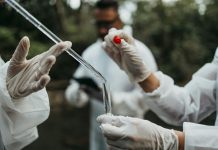
Every day, vast amounts of the food we produce end up wasted, either in landfills, sewers, or elsewhere.
In 2022, the United Nations reported that a staggering 1.05 billion tons of food were wasted globally—about 132 kilograms per person.
Among the most wasted foods is milk, with one in six liters of milk produced worldwide going to waste.
A new invention—a tiny microchip—could change that and help save millions of liters of milk from going down the drain.
The problem: wasted milk in production
Milk is one of the most commonly wasted foods, and the root cause of this waste often starts in the production process.
According to a study from the University of Edinburgh, every dairy in the world pours an average of 10,000 liters of milk down the drain each day. Surprisingly, this milk is not spoiled; it is completely fresh.
However, it is wasted when milk is used to flush out the pipes that transport milk through production plants.
This flushing process is necessary to ensure that any leftover cleaning fluid from washing the pipes between production runs is completely removed. Unfortunately, this practice leads to enormous amounts of perfectly good milk being wasted every single day.
A new solution: the milk-saving microchip
To tackle this problem, a group of researchers and tech companies in the Nexus consortium has developed a compact optical spectrometer in the form of a microchip.
This tiny device can detect the amount of liquid, fat, and proteins in the pipes, allowing dairies to see whether there are any milk residues or cleaning products present.
By using this microchip, dairy workers can avoid unnecessary waste by only flushing the pipes when absolutely necessary, instead of using large amounts of milk as a precautionary measure. This could significantly reduce the amount of milk wasted in the production process.
Why milk waste matters
The environmental impact of milk waste is significant. Cows produce methane, a powerful greenhouse gas, which contributes to climate change. Although beef production is often associated with higher emissions, milk production still has a notable impact. On average, one liter of cow’s milk accounts for 3.15 kilograms of CO2 equivalents, a measure that compares the impact of different greenhouse gases on global warming.
When you multiply that by the 10,000 liters of milk wasted daily in every dairy, the environmental cost becomes staggering. Reducing this waste could significantly lower the dairy industry’s carbon footprint, helping to combat climate change.
Currently, dairies use expensive spectrometers—devices that can detect what is flowing through the pipes—to monitor production. However, these devices cost around EUR 100,000 each, making them too costly to use extensively throughout the production process.
The new microchip developed by the Nexus team is much smaller, more affordable, and just as effective. This means that dairies can install multiple microchips throughout their facilities, allowing them to monitor milk production more precisely and reduce waste.
Beyond milk: a tool for food safety
The potential of this microchip goes beyond just saving milk. The technology could also improve food safety in countries where food control is less strict. By using these microchips to monitor production, it would be easier to identify any unwanted ingredients or contaminants in the food supply, potentially saving lives.
While the microchip is still being tested, the team behind it is optimistic. They believe that with further development, this technology could revolutionize not just milk production, but food safety around the world.
In conclusion, this tiny microchip could make a huge difference in reducing milk waste, lowering greenhouse gas emissions, and improving food safety globally. It’s a small innovation with the potential for a big impact—saving both milk and the planet.
Source: KSR.



